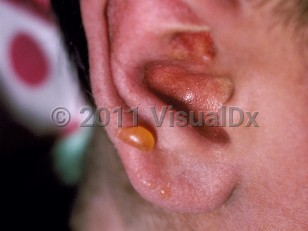Acute graft-versus-host disease in Infant/Neonate
Alerts and Notices
Important News & Links
Synopsis

Graft-versus-host disease (GVHD) refers to organ dysfunction resulting from the introduction of foreign immunocompetent lymphocytes or bone marrow tissue (the graft) into an immunologically defective host. Acute GVHD in infants is usually secondary to engraftment of maternally transmitted or transfusion-derived T lymphocytes in infants with severe combined immunodeficiency (SCID). Acute disease typically presents as a morbilliform eruption that may progress to erythroderma or a toxic epidermal necrolysis-like picture.
Codes
ICD10CM:
D89.810 – Acute graft-versus-host disease
SNOMEDCT:
402355000 – Acute graft-versus-host disease
D89.810 – Acute graft-versus-host disease
SNOMEDCT:
402355000 – Acute graft-versus-host disease
Look For
Subscription Required
Diagnostic Pearls
Subscription Required
Differential Diagnosis & Pitfalls

To perform a comparison, select diagnoses from the classic differential
Subscription Required
Best Tests
Subscription Required
Management Pearls
Subscription Required
Therapy
Subscription Required
References
Subscription Required
Last Updated:01/10/2018

